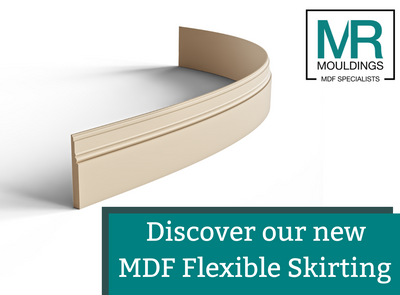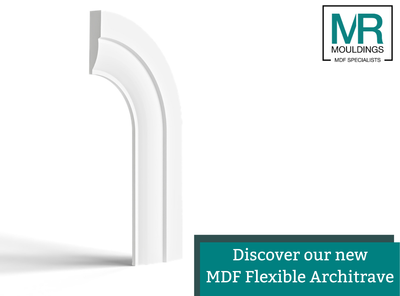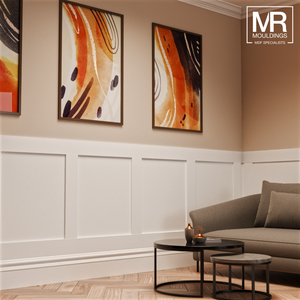
Should Skirting Boards Be Flush with the Floor? Installation Tips Explained
When installing skirting boards, one of the most common questions, especially from DIYers or first-time renovators, is: should skirting boards be flush with the floor? It might seem like a simple detail, but the answer can impact the finish, performance, and durability of your flooring and trim.
Skirting boards should sit flush with the floor for a clean, professional look. This ensures gaps are covered and prevents dust build-up. Uneven floors may require scribing or packing for a tight fit. Proper alignment also helps achieve seamless joins with flooring, improving both durability and overall visual finish.
In this guide, we’ll break down exactly what it means for skirting boards to sit flush, explore how floor type and installation method influence placement, and share expert tips to help you achieve a seamless result, whether you're working with MDF skirting, carpet, laminate, or tile.
What Does “Flush with the Floor” Actually Mean?
A skirting board being flush with the floor means the bottom edge of the skirting sits tightly against the floor surface with no visible gap. This gives the cleanest look, but it’s not always straightforward to achieve or even desirable in every situation.
Depending on:
-
The type of floor (carpet, wood, laminate, tile, etc.)
-
The order of installation (flooring first or skirting first)
-
The wall/floor levels (which may be uneven)
...you may need to leave a small gap, scribe the skirting to the floor contour, or use flexible caulking to fill any inconsistencies.
Should Skirting Boards Touch the Floor? It Depends on the Flooring Type
The key factor in determining whether your skirting should be flush is the type of flooring you're working with. Let’s break it down by surface:
With Carpet
-
Common approach: Fit the skirting slightly above the subfloor (typically 10–15mm)
-
This allows the carpet and underlay to be tucked underneath
-
Creates a snug finish and avoids compressing the pile
Tip: Fitters often install skirting before carpet, making it easier to get sharp edges and avoid paint damage during fitting.
With Laminate or Hardwood Flooring
-
Skirting is usually fitted on top of the finished floor or designed to cover the expansion gap
-
Floating floors need space to expand and contract, so a small perimeter gap (5–10mm) is left, which skirting helps conceal
-
Boards can be flush with the floor or have caulking for ultra-clean joins
Avoid pinning skirting boards directly to the floating floor. Always fix them to the wall so the floor can move independently.
With Tiled Floors
-
Tiled floors are hard and level, so flush fitting is ideal
-
Use decorators' caulk or silicone to seal the edge and prevent dirt ingress
-
Often seen in kitchens, bathrooms, and utility rooms
With Floating Floors (e.g. LVT, engineered wood)
-
Leave an expansion gap around the perimeter
-
Skirting is then fitted over the top to hide this
-
Alternatively, a separate scotia trim or quadrant can be used if skirting is already in place
Why a Small Gap Might Be Needed During Installation
It’s tempting to want the skirting board to sit tightly on the floor, but this isn’t always practical. Here’s why a slight gap might be useful:
-
Expansion and contraction: Especially for wood and laminate flooring, which naturally expand and contract with humidity.
-
Uneven floors: Old or uneven subfloors can create visible gaps or pressure points unless skirting is scribed to fit.
-
Future-proofing: Leaving a gap gives flexibility if floors are changed later, e.g. replacing carpet with a thicker underlay.
Tip: For DIYers fitting MDF skirting, use spacers or wedges to ensure consistent height above the floor before fixing.
Should Skirting Be Fitted Before or After Flooring?
This is one of the most debated questions among installers. Here’s how the two approaches compare:
Skirting First
-
Often used with carpets or when walls are being decorated before floors
-
Easier to paint/skim walls without damaging floors
-
Flooring (like carpet or vinyl) is tucked under the skirting for a clean finish
Flooring First
-
Common with laminate, hardwood, or tile
-
Skirting is fitted after the flooring to cover the expansion gap
-
Requires careful measuring and neat edge work
There’s no universal rule, but the best approach is often determined by flooring type and installation sequence. MDF skirting boards are flexible enough to work in both scenarios; just be sure to plan ahead.
How to Achieve a Professional Skirting Finish
Whether your skirting is flush or slightly gapped, the most important thing is a smooth, sealed edge between the wall and floor.
Here’s how to get that polished finish:
-
Use decorators' caulk to fill small gaps for painted finishes
-
Scribe the skirting to the floor if it's uneven; this involves cutting the bottom edge to match the floor profile
-
Seal the bottom edge in bathrooms or kitchens with silicone to prevent water ingress
-
Paint before or after fitting depending on access and flooring sensitivity
Tip: Flexible MDF skirting boards are ideal for curved walls or inconsistent surfaces, they bend to shape while offering a flawless surface to paint.
What If There’s Already a Gap Under My Skirting?
If you’ve moved into a property and noticed a visible gap under your skirting, don’t worry, it’s more common than you think.
You have a few options:
-
Use caulk or sealant to fill gaps (for painted skirting)
-
Install scotia or quadrant trim to conceal the gap
-
Add a narrow skirting board over the existing one for a layered look
-
Leave it if the finish looks acceptable and dust isn’t collecting
Small gaps are often functional, especially in older homes or with floating floors. The key is ensuring the gap doesn’t let in draughts or become a dirt trap.
MDF vs Wood Skirting – Does It Affect Installation?
Yes, the material you choose for your skirting boards can influence how flush they sit with the floor and how easy they are to install.
MDF Skirting Boards
-
Consistent height and shape, perfect for flush finishes
-
Available pre-primed for quick decorating
-
Moisture-resistant MDF is ideal for kitchens and bathrooms
-
Easier to cut and scribe than natural wood
-
Less prone to warping or splitting
Solid Wood Skirting
-
Natural grain variation can lead to height inconsistencies
-
May require more sanding or adjustment
-
Can warp over time if exposed to moisture
At MR Mouldings, we recommend primed MDF skirting for most applications, especially if you’re looking for a clean, paintable, flush finish.
Frequently Asked Questions
Should skirting boards touch the floor?
It depends on your floor type. For laminate and hardwood, they usually sit on top. For carpet, a small gap is often left so the carpet can be tucked underneath.
Can you fit skirting boards before the flooring?
Yes, this is common when fitting carpet or finishing walls early. Just ensure you account for floor thickness so your skirting sits at the right height.
Is a small gap under the skirting a problem?
Not necessarily. It can be filled with caulk or covered with trim. It’s more important that the gap doesn’t cause draughts or look visually uneven.
Should I paint the skirting before or after fitting?
Painting before fitting gives a cleaner finish, but some touch-up may still be needed after fixing. If the flooring is already in place, painting after can help avoid scratches.
What’s the easiest skirting material to fit flush?
MDF skirting boards are lightweight, smooth, and easy to scribe to uneven floors.
Final Thoughts – It's All About a Clean, Sealed Finish
So, should skirting boards be flush with the floor? The answer is: it depends on your flooring, your installation sequence, and your desired look.
What matters most is:
-
Covering expansion gaps effectively
-
Preventing dust and draughts
-
Creating a clean, seamless join between wall and floor
With MR Mouldings’ MDF skirting boards, achieving a professional flush finish is simple, thanks to their precision profiles, flexible options, and easy-to-decorate surface.
Explore Our MDF Skirting Range
Looking for skirting boards that are easy to fit, primed and ready to paint, and available in a wide range of styles?
Browse our full collection:
👉 MDF Skirting Boards
👉 Flexible Skirting Options
👉 Architraves and Matching Mouldings




